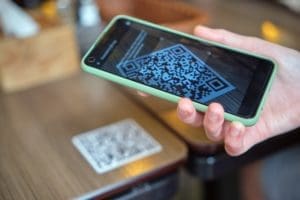 In the hazy “before times” of late 2019 and early 2020, the QR Code was the butt of many jokes. A QR Code seemed passé—almost like putting “e” or “I” at the beginning of a new device’s name and considering it techy and hip. But then along came a deadly global pandemic, when no one wanted to touch a restaurant menu, and the QR Code had its revenge—even starring in one of the hottest Super Bowl ads of 2022.
In the hazy “before times” of late 2019 and early 2020, the QR Code was the butt of many jokes. A QR Code seemed passé—almost like putting “e” or “I” at the beginning of a new device’s name and considering it techy and hip. But then along came a deadly global pandemic, when no one wanted to touch a restaurant menu, and the QR Code had its revenge—even starring in one of the hottest Super Bowl ads of 2022.
But the QR Code wasn’t originally designed to sell cryptocurrency or daily specials. The first QR Codes were developed in Japan in the early 1990s by Denso Wave, a Toyota subsidiary, to expedite automobile manufacturing. In 1992, engineer Masahiro Hara was tasked with invented a bar code that could hold more data. A barcode that could hold only 20 characters wasn’t adequate for use in managing Toyota’s massive parts inventory. Workers were found themselves scanning up to 1,000 codes a day as they made do by placing multiple bar codes on a single part.
Hara needed a compact code that could hold more data and be scanned quickly. Inspiration struck during a lunchtime game of the strategy game Go. Looking at the game board, he realized how much data its grid pattern could contain—and that by adding a position detection pattern, such a code could always be scanned accurately. The QR Code’s iconic three corners are based on the ratio 1:1:3:1:1. Hara’s “Quick Response Code” could store 7,000 characters, including Kanji characters, and could be read 10 times faster than traditional bar codes.
As the COVID-19 pandemic evolves, the future for QR Code use is anybody’s guess—but because we’ve all discovered its conveniences and smartphones are so ubiquitous, it’s hard to imagine they will fade away. Plus, QR Codes are now part of the cybercriminal’s arsenal, with the FBI issuing a warning about malicious code use in January.
Photo: Bilanol / Shutterstock

In retail, QR codes are an improvement because they can put multiple items on a receipt, such as all the individual parts of a suit, but it doesn’t appear to have caught on with retailers just yet.